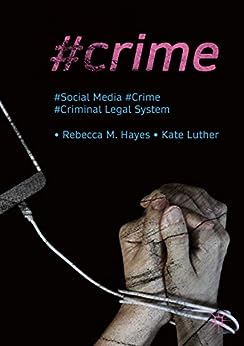
Rebecca M. Hayes and Kate Luther in #Crime: Social Media, Crime, and the Criminal Legal System (published by Palgrave Macmillan in 2018) explore connections between crime and media. The book discusses how the public utilizes new media to learn about incidents of crime, document criminal motivations by perpetrators, aid law enforcement investigations and react to injustices in the criminal legal system.
Important scholars in the field of crime, criminology and media studies such as Ray Surette, Chris Greer, Stuart Hall, Yvonne Jewkes, and others are engaged. It contains a rich discussion on how crime is represented in an era of global interconnectedness. An interesting dimension is introduced about how images are reshaping our universe of information about the world in general and criminology in particular. Intervention by scholars bringing in examples from their local contexts will enrich the discussion and broaden our understanding of the effect, impact and influence of rapidly changing new media technology on the criminal legal system.
Hayes and Luther use keywords like image, iconography, information flows, the counter-visual, social media, signs, and inscriptions of gender, race, sexuality and class in cultural contests to mark the contours of the crime and media nexus. They discuss the characteristics of social media; its nature of amplifying the information, allowing people to instantly see and respond to the information posted online. Also, how social media ties all media together. Additionally, trends in media consumption, and the application of theories such as “social construction”, “moral panics”, “folk devil”, and “cultivation theory” are discussed. The authors make an interesting observation that “the internet should not be seen as just technology but as technologically enabled social practice”.
In the digital age, there is certainly greater use of social media platforms, as the authors argue, with increased access to social media sites with the use of smartphones and tablets. Swati Chaturvedi’s work, “Trolling Trends” published in the Indian context may provide a different perspective in understanding how the rapidly changing new media dynamics are influencing the informational flow, generating fake news or misinformation. Speed and time are important dimensions of these emerging dynamics, giving birth to new forms of criminal activity while constituting potential audiences in a historically impossible manner.
The interactive new media have allowed audience participation, as authors discuss, by sharing real-time information on social media. They are posting live videos, images, locations, times, etc. The authors could enrich this discussion by including a point on how it creates a plethora of information for the police and the state. Besides, as the authors point out, citizen journalism is also intensifying. Individual journalists bringing news coverage reportage on social media platforms is also a unique phenomenon. Barkha Dutt’s MoJo Story, Ravish Kumar’s YouTube channel and Faye D’Souza’s Instagram page “News that Should be Headlines” are cases in point.
The impact of the internet on courts is an under-researched area, although Hayes and Luther discuss it in the US context. However, both police and court are adapting to the new media technology; making it optional for people to register online FIR, telecasting live the courtroom proceedings and uploading the judgment online. Recently, as witnessed how during the COVID-19 pandemic-induced lockdown the trials, court proceedings, etc. were conducted online. It reflects the influence of technology on the criminal legal system. However, one must not assume easy access to required resources. Sherry Turkle’s work appears relevant here, as the scholar rightly indicates that connecting to the networked systems of communications has become a necessity as it is reshaping our relations and imaginations around the informational universe.
The readers shall agree with the author’s point that media representations influence our common understanding of who is and is not a criminal. Visual media representations such as crime serials, cinema, and web series in particular re-enforce our popular imaginations. Likewise, they call attention to changing social construction of victims and see potential in social media to act as a platform for counter-publics. However, such counter-public engagement is often limited and varies proportionately case by case. Instead, it may end in creating an echo chamber, particularly when it lacks mobilisation or support from relevant social networks.
Having said that, one will not be wrong in opining that we live in a heavily media-influenced environment. In that context, the book is a must-read for scholars working in the field of crime and/or media studies. For scholars using the content analysis method, studying effects research or observing media production processes, it is a suggested reference. It is a compact yet easy-to-read book for general readers, college students and classroom references.
***
Twinkle Siwach has a PhD in Media Studies from Jawaharlal Nehru University (JNU), New Delhi. Her research interests are crime and violence, police and media studies.